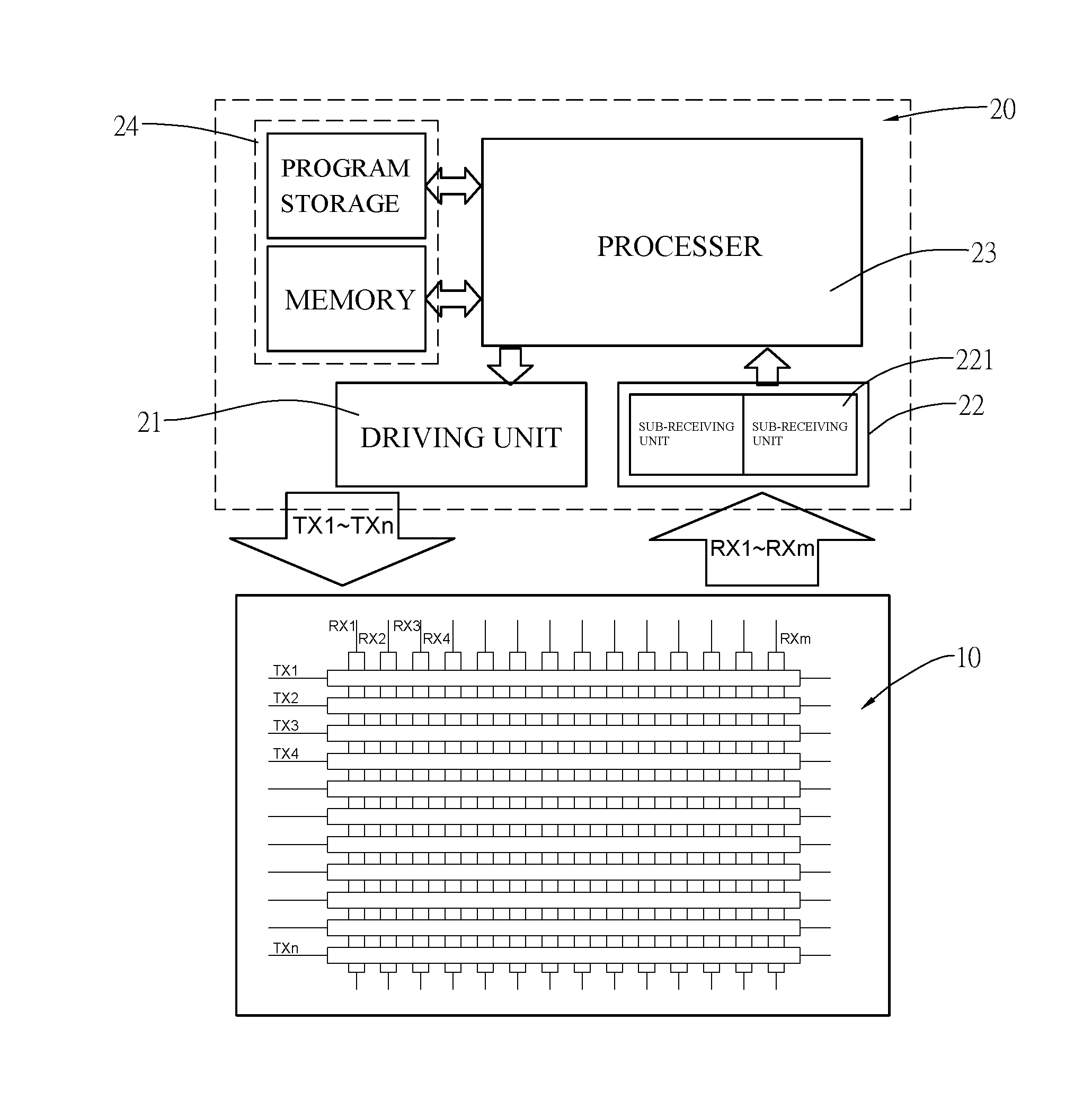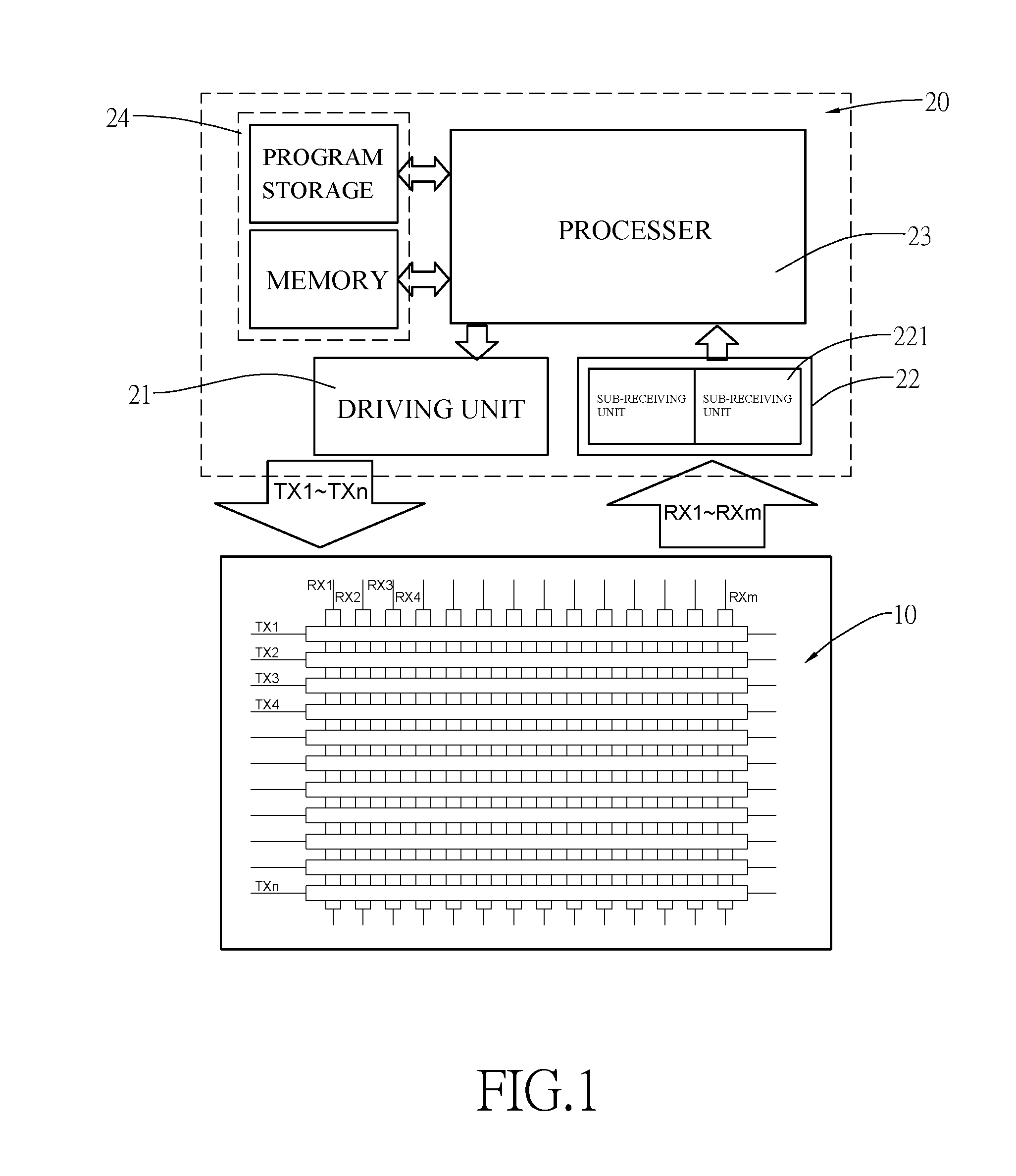Scan method for a touch panel and touch device
a touch panel and scanning method technology, applied in the field of scanning methods for touch panels, can solve the problems of still waste electricity and waste electricity, and achieve the effect of overcoming the shortcoming of a conventional scanning method, low electricity cost, and high sensing valu
- Summary
- Abstract
- Description
- Claims
- Application Information
AI Technical Summary
Benefits of technology
Problems solved by technology
Method used
Image
Examples
first embodiment
[0060]With reference to FIG. 1, the touch device in accordance with the present invention comprises a touch panel 10 and a controller 20.
[0061]The touch panel 10 has p traces including multiple first-axis traces and second-axis traces across each other. Taking self-capacitance scanning as an example, the p traces are both the driving lines and the receiving lines, taking mutual-capacitance scanning as shown in FIG. 1 as an example, the first-axis traces TX1˜TXn are the driving lines and the second-axis traces RX1˜RXm are the receiving lines.
[0062]The controller 20 connects to the touch panel 10 and includes a driving unit 21, a receiving unit 22, a processor 23 and a memory unit 24. The processor 23 controls the driving unit 21 to drive the driving lines of the touch panel 10. The receiving unit 22 receives the sensing signal from the receiving line of the touch panel 10 and then the processor 23 further deals with the sensing signal. In the first embodiment, the first-axis trace TX...
second embodiment
[0075]With the reference of FIG. 5, the steps of the scan method in accordance with the present invention S11˜S14 is the same with the steps S11˜S14 in the flow chart shown as FIG. 2 and adds steps for adjusting the baseline. The step S14 includes the following steps: Adjusting the first baseline and the first threshold: The first baseline and the first threshold are further compared when no touch object is determined by the processor 23 (S18). Based on the comparison result, the first baseline or the first threshold is adjusted and the adjusted first baseline or the adjusted first threshold is stored back to the memory unit 24; or the first baseline is adjusted first, and then the first threshold is adjusted based on the adjusted first baseline (S20). The adjusted first threshold is stored back to the memory unit 24. Then the sleep mode S17 is entered and the step S171 is executed. When the first sensing signal is bigger than the first baseline, a V1 value is added to the first bas...
third embodiment
[0087]With reference of FIG. 8, the scan method in accordance with the present invention has following steps:
[0088]Executing the first ADC calibration (S31): The first ADC calibration is executed to acquire the first baseline and the first threshold is set based on the first baseline;
[0089]Acquiring the first sensing signal (S32): The i traces are driven and the sensing signals of the j traces are received simultaneously;
[0090]Determining whether touch object exists (S33): The first sensing signals are compared with the first threshold to determine whether touch object exists;
[0091]Calculating the coordinate of the touch object (S34): if the touch object do exist, the coordinate of the touch object is determined and return to the steps of acquiring the first sensing signal (S32);
[0092]Determining if all the traces has scanned (S331): Whether all of the default traces has scanned or not are determined. If not all of the default traces are scanned, return back to the step (S32). If al...
PUM
 Login to View More
Login to View More Abstract
Description
Claims
Application Information
 Login to View More
Login to View More - R&D
- Intellectual Property
- Life Sciences
- Materials
- Tech Scout
- Unparalleled Data Quality
- Higher Quality Content
- 60% Fewer Hallucinations
Browse by: Latest US Patents, China's latest patents, Technical Efficacy Thesaurus, Application Domain, Technology Topic, Popular Technical Reports.
© 2025 PatSnap. All rights reserved.Legal|Privacy policy|Modern Slavery Act Transparency Statement|Sitemap|About US| Contact US: help@patsnap.com



